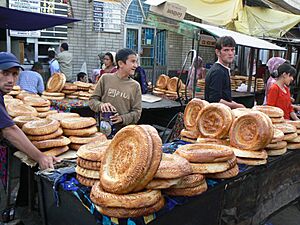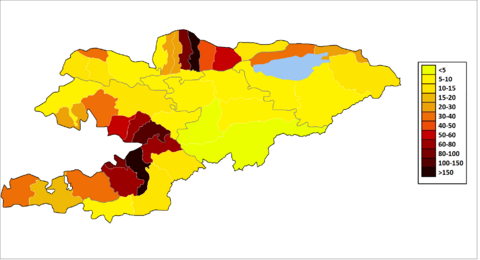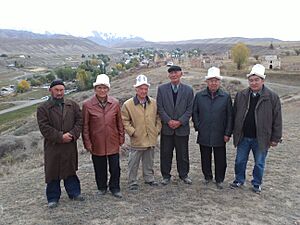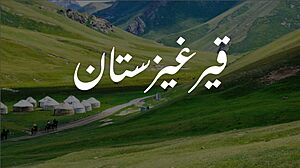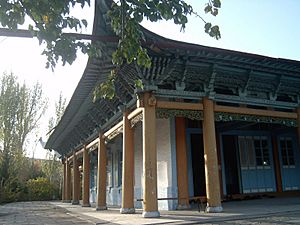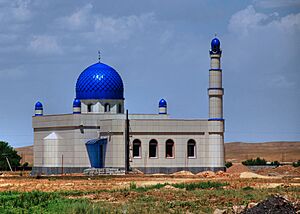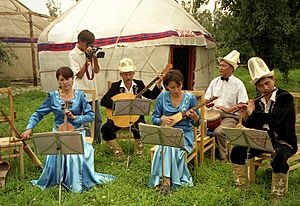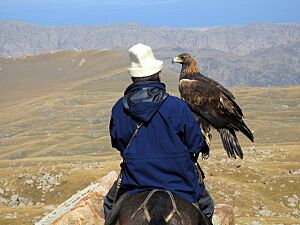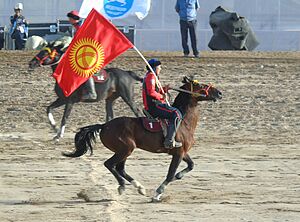Kyrgyzstan facts for kids
Quick facts for kids
Kyrgyz Republic
|
|
|---|---|
|
|
|
|
Anthem: Кыргыз Республикасынын Мамлекеттик гимни (Kyrgyz)
National Anthem of the Kyrgyz Republic |
|
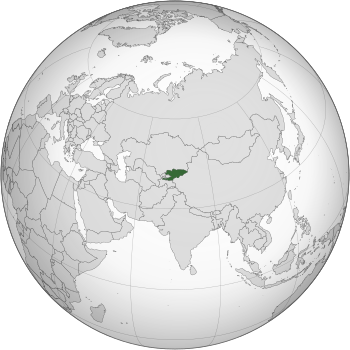
Location of Kyrgyzstan (dark green)
|
|
| Capital and largest city
|
Bishkek 42°52′N 74°36′E / 42.867°N 74.600°E |
| Official languages | |
| Official script | Cyrillic |
| Ethnic groups
(2024)
|
|
| Religion
(2021)
|
|
| Demonym(s) | Kyrgyz Kyrgyzstani |
| Government | Unitary presidential republic |
| Sadyr Japarov | |
| Akylbek Japarov | |
|
• Speaker of the Supreme Council
|
Nurlanbek Shakiev |
| Legislature | Supreme Council |
| Formation History | |
|
• Kyrgyz Khaganate
|
539 |
| 1876 | |
|
• Kara-Kirghiz AO
|
14 October 1924 |
|
• Kirghiz ASSR
|
11 February 1926 |
|
• Kirghiz SSR
|
5 December 1936 |
|
• Sovereignty declared
|
30 December 1990 |
|
• Independence declared from USSR
|
31 August 1991 |
| 26 December 1991 | |
|
• Current constitution
|
11 April 2021 |
| Area | |
|
• Total
|
200,105 km2 (77,261 sq mi) (85th) |
|
• Water
|
7,198 km2 (2,779 sq mi) |
|
• Water (%)
|
3.6 |
| Population | |
|
• 2024 estimate
|
7,213,455 (107th) |
|
• Density
|
37/km2 (95.8/sq mi) (109th) |
| GDP (PPP) | 2024 estimate |
|
• Total
|
|
|
• Per capita
|
|
| GDP (nominal) | 2024 estimate |
|
• Total
|
|
|
• Per capita
|
|
| Gini (2020) | ▲ 29.0 low |
| HDI (2022) | high · 117th |
| Currency | Kyrgyzstani som (c) (KGS) |
| Time zone | UTC+6 (KGT) |
| Date format | dd/mm/yyyy |
| Driving side | right |
| Calling code | +996 |
| ISO 3166 code | KG |
| Internet TLD | .kg |
Kyrgyzstan, also known as the Kyrgyz Republic, is a country in Central Asia. It is a landlocked country, meaning it has no access to the ocean. Kyrgyzstan is famous for its many mountains.
The country shares borders with Kazakhstan to the north, Uzbekistan and Tajikistan to the west and southwest, and China to the east. Its capital and largest city is Bishkek.
Kyrgyzstan has a long history, going back over 2,000 years. Even though its mountains kept it somewhat separate, Kyrgyzstan was an important stop on the Silk Road. This was a famous ancient trade route.
For a long time, different tribes and groups lived here. Kyrgyzstan became an independent country in 1991. This happened after the Soviet Union broke apart.
Since then, Kyrgyzstan has been a single presidential republic. It is a member of many international groups. These include the United Nations and the Eurasian Economic Union.
Most of Kyrgyzstan's six million people are Kyrgyz. There are also many Uzbeks and Russians. The main language is Kyrgyz, which is like other Turkic languages. But Russian is also an official language. Most people in Kyrgyzstan are Muslim.
Contents
- Exploring Kyrgyzstan's Geography
- Understanding Kyrgyzstan's Climate
- How Kyrgyzstan is Governed
- Regions and Cities of Kyrgyzstan
- Kyrgyzstan's Economy
- People of Kyrgyzstan
- Languages Spoken in Kyrgyzstan
- Religion in Kyrgyzstan
- Kyrgyz Culture and Traditions
- Education in Kyrgyzstan
- See also
- Images for kids
Exploring Kyrgyzstan's Geography
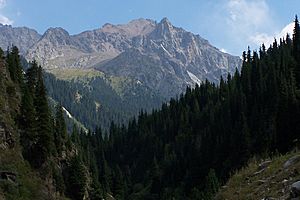
Kyrgyzstan is a very mountainous country. Over 80% of its land is covered by mountains. The highest point is Peak Jengish Chokusu, which is 7,439 meters (24,406 feet) tall. The tallest peaks are found in the Kakshaal-Too range.
Issyk-Kul Lake is the biggest lake in Kyrgyzstan. It is the largest mountain lake in Asia. It is also the second largest mountain lake in the world.
Bishkek, the capital, is in the northern part of the country. The second largest city is Osh, which is a very old town.
Understanding Kyrgyzstan's Climate
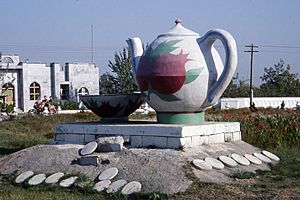
The weather in Kyrgyzstan changes a lot depending on where you are. The Fergana Valley in the southwest is subtropical. It gets very hot in summer, sometimes reaching 40°C (104°F).
The northern foothills have a temperate climate. The Tian Shan mountains have a climate that ranges from dry continental to polar climate. This depends on how high up you are.
In the coldest areas, temperatures stay below freezing for about 40 days in winter. Even some desert areas get snow. In the lowlands, temperatures are about -6°C (21°F) in January. They rise to about 24°C (75°F) in July.
How Kyrgyzstan is Governed
Kyrgyzstan is a democratic unicameral republic. This means it has one main law-making body. The country has a president and a prime minister. The main court system includes a supreme court and local courts.
In April 2021, people voted for a new constitution. This new constitution gave more power to the president. It made the presidency much stronger.
Regions and Cities of Kyrgyzstan
Kyrgyzstan is divided into seven main regions. These regions are then split into 44 smaller districts. The districts are further divided into rural areas.
The cities of Bishkek and Osh are special. They are considered "state importance" cities. This means they do not belong to any region.
Each region has a governor. The president chooses these governors.
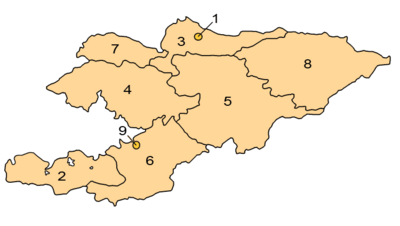
Here are the regions and independent cities:
- City of Bishkek
- Batken Region
- Chüy Region
- Jalal-Abad Region
- Naryn Region
- Osh Region
- Talas Region
- Issyk-Kul Region
- City of Osh
Kyrgyzstan's Economy
The National Bank of the Kyrgyz Republic is the country's central bank. Kyrgyzstan faces economic challenges. It is one of the poorer countries in Central Asia. About 22.4% of its people live below the poverty line.
After gaining independence, Kyrgyzstan had economic problems. This was because the Soviet trade system broke down. The country lost its main markets.
The government has worked to improve the economy. They have cut spending and added a value-added tax. Kyrgyzstan joined the World Trade Organization (WTO) in 1998.
Many Kyrgyz people work in Russia. They send money back home, which helps the economy. However, these payments have gone down recently.
Agriculture is a very important part of the economy. It makes up about 35.6% of the country's total production. About half of all jobs are in agriculture. The mountainous land is good for raising livestock. So, wool, meat, and dairy products are important goods. Farmers also grow wheat, sugar beets, potatoes, and cotton.
Kyrgyzstan has many mineral resources. These include coal, gold, and uranium. But it does not have much petroleum or natural gas. The country has to import these. Metallurgy, which is working with metals, is a key industry.
Kyrgyzstan's main exports are metals, farm products, and electricity. It imports oil, gas, and machinery. Its main trade partners are Germany, Russia, China, Kazakhstan, and Uzbekistan. China has also started many large building projects in Kyrgyzstan.
The COVID-19 pandemic has hurt Kyrgyzstan's economy. The World Bank is helping the country with money for different projects. This support aims to lessen the economic impact.
Tourism in Kyrgyzstan
One of the most popular places for tourists is Issyk-Kul Lake. Many hotels and resorts are located along its northern shore. Popular beach areas are in Cholpon-Ata and nearby towns.
Over a million tourists visited the lake in 2006 and 2007. However, due to problems in the region, the number has decreased.
People of Kyrgyzstan
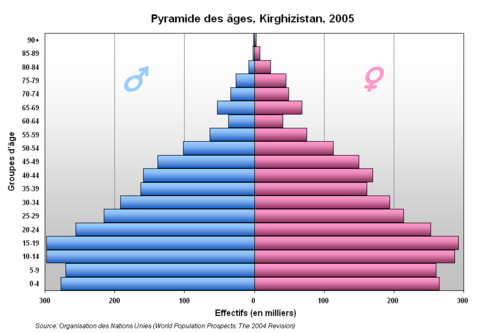
In August 2020, Kyrgyzstan's population was about 6.5 million people. About 34.4% of the people are under 15 years old. Only about one-third of the population lives in cities.
Ethnic Groups in Kyrgyzstan
The largest ethnic group is the Kyrgyz. They are a Turkic group and make up 77.8% of the population. Other groups include Uzbeks (14.2%) and Russians (3.8%). There are also smaller groups like Dungans and Tajiks. The country has over 80 different ethnic groups.
The Kyrgyz people were traditionally semi-nomadic herders. They lived in round tents called yurts. They raised sheep, horses, and yaks. This tradition continues today. Many families still move to high mountain pastures in the summer.
Since Kyrgyzstan became independent, the number of ethnic Kyrgyz people has grown. The number of Russians, Ukrainians, and Germans has decreased. Many Germans, for example, have moved to Germany.
| Kyrgyz | Uzbeks | Russians | Ukrainians | ||
|---|---|---|---|---|---|
| 1926 census | Number | 661,171 | 110,463 | 116,436 | 64,128 |
| % |
66.6%
|
11.1%
|
11.7%
|
6.5%
|
|
| 1959 census | Number | 836,831 | 218,640 | 623,562 | 137,031 |
| % |
40.5%
|
10.6%
|
30.2%
|
6.6%
|
|
| 1989 census | Number | 2,229,663 | 550,096 | 916,558 | 108,027 |
| % |
52.4%
|
12.9%
|
21.5%
|
2.5%
|
|
| 1999 census | Number | 3,128,147 | 664,950 | 603,201 | 50,442 |
| % |
64.9%
|
13.8%
|
12.5%
|
1.0%
|
|
| 2009 census | Number | 3,804,788 | 768,405 | 419,583 | 21,924 |
| % |
70.9%
|
14.3%
|
7.8%
|
0.4%
|
|
| 2022 census | Number | 5,379,020 | 986,881 | 282,777 | 3,875 |
| % |
77.6%
|
14.2%
|
4.1%
|
0.1%
|
|
| 2024 estimate | Number | 5,570,910 | 1,017,658 | 274,940 | 2,783 |
| % |
77.8%
|
14.2%
|
3.8%
|
0.0%
|
|
Languages Spoken in Kyrgyzstan
Kyrgyz is the official state language of Kyrgyzstan. Russian is also an official language. Kyrgyzstan is one of five former Soviet countries that still use Russian as an official language.
Kyrgyz became the state language in 1991. Russian was made an official language in 1997.
Religion in Kyrgyzstan
Islam is the main religion in Kyrgyzstan. Most Muslims here follow the Sunni branch of Islam.
Other religions practiced include different types of Christianity. These are mainly followed by Russians and Ukrainians.
Kyrgyz Culture and Traditions
Unique Kyrgyz Traditions
- Manas: A very long epic poem. It tells stories about the history of the region in the 9th century. It focuses on how the Kyrgyz people interacted with other groups.
- Komuz: A musical instrument with three strings, similar to a lute.
- Tush kyiz: Large, beautifully embroidered wall hangings.
- Shyrdak and Ala-kiyiz carpets: These are special carpets made from felt. They are used in yurts. UNESCO has recognized them as important cultural heritage.
- Other textiles: Many other items are made from felt.
- Ala kachuu: This is a traditional form of marriage in Kyrgyzstan, sometimes called "bride kidnapping."
- Falconry: Hunting with trained eagles or falcons.
- Various dances.
The National Flag of Kyrgyzstan
The national flag has a yellow sun with 40 rays in the middle. These 40 rays stand for the 40 tribes that formed the Kyrgyz culture. The lines inside the sun represent the tündük (Kyrgyz түндүк). This is the crown or top opening of a yurt. It is a common symbol in Kyrgyz buildings. The red part of the flag means peace and openness.
Before 1992, when Kyrgyzstan was part of the Soviet Union, it had a different flag.
Public Holidays in Kyrgyzstan
Kyrgyzstan celebrates New Year on January 1st. They also celebrate the traditional New Year festival, Nowruz, in spring. This spring holiday includes feasts and horse games like Ulak Tartish.
Here are some of the public holidays in Kyrgyzstan:
- 1 January – New Year's Day
- 7 January – Orthodox Christmas
- 23 February – Fatherland Defender's Day
- 8 March – Women's Day
- 21–23 March – Nooruz Mairamy, Persian New Year (spring festival)
- 7 April – Day of National Revolution
- 1 May – Labor Day
- 5 May – Constitution Day
- 8 May – Remembrance Day
- 9 May – Victory Day
- 31 August – Independence Day
- 7–8 November – Days of History and Commemoration of Ancestors
There are also two Muslim holidays, Orozo Ayt and Qurman (or Qurban) Ayt. Their dates change each year based on the lunar calendar.
Popular Sports in Kyrgyzstan
Football is the most popular sport in Kyrgyzstan. The Football Federation of Kyrgyz Republic manages the sport. It was started in 1992.
Wrestling is also very popular. Kyrgyzstani wrestlers have won several medals at the Olympic Games.
Ice hockey has become more popular recently. In 2011, the Kyrgyzstan men's national ice hockey team won the 2011 Asian Winter Games Premier Division. This was their first big international event.
Bandy is also growing in popularity. The Kyrgyz national team won a bronze medal at the Asian Winter Games. They also played in the Bandy World Championship 2012.
In mixed martial arts, Valentina Shevchenko is a famous fighter from Kyrgyzstan. She is a champion in the Ultimate Fighting Championship (UFC).
Dmitry Bivol is a professional boxer from Kyrgyzstan. He holds a world title in the Light Heavyweight division.
Kyrgyzstan's national basketball team did very well in the 1995 Asian Basketball Championship. They finished ahead of strong teams like Iran and the Philippines.
The first three World Nomad Games were held in Cholpon-Ata, Kyrgyzstan. These games celebrate traditional nomadic sports.
Horse Riding and Traditional Games
Traditional national sports show how important horse riding is in Kyrgyz culture.
Ulak Tartysh is very popular. It is a team game played on horseback. Two teams of riders try to get a headless goat carcass. They then try to score by getting it into a goal.
Other popular games on horseback include:
- At Chabysh: A long-distance horse race, sometimes over 50 km.
- Jumby Atmai: Riders try to break a thread holding a metal bar by shooting at it while galloping.
- Kyz Kuumai: A man chases a girl on horseback to win a kiss. If he fails, she can chase him back and hit him with a horsewhip.
- Oodarysh: Two riders wrestle on horseback. Each tries to throw the other off their horse.
- Tyin Emmei: Picking up a coin from the ground while riding at full gallop.
Education in Kyrgyzstan
The school system in Kyrgyzstan includes primary (grades 1-4), secondary (grades 5-9), and high school (grades 10-11). Children usually start primary school at age 6 or 7. Every child must finish 9 grades and get a certificate. Grades 10-11 are optional, but needed to get a high school diploma. To graduate, students must pass four state exams.
There are 77 public schools in Bishkek and over 200 in the rest of the country. Kyrgyzstan also has 55 higher education institutions and universities.
In September 2016, the University of Central Asia opened in Naryn. There are also many Russian-language schools. These schools often get more funding than Kyrgyz state schools. Because of this, many Kyrgyz students attend them.
Libraries in Kyrgyzstan
Kyrgyzstan has 1,066 libraries. The National Library of the Kyrgyz Republic is the oldest, started in 1934. Kyrgyz libraries are working to give more people access to books and information.
See also
 In Spanish: Kirguistán para niños
In Spanish: Kirguistán para niños
Images for kids
-
Silk road caravansarai utilized during the Islamic Golden Age
-
Urial on a Kyrgyzstan stamp





